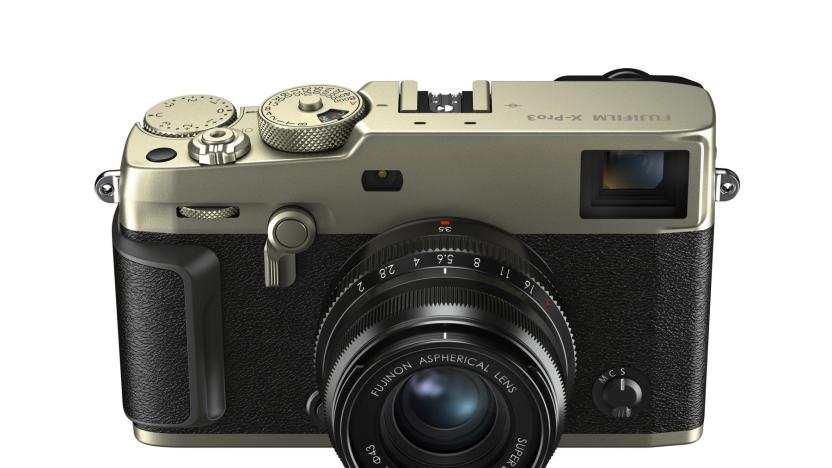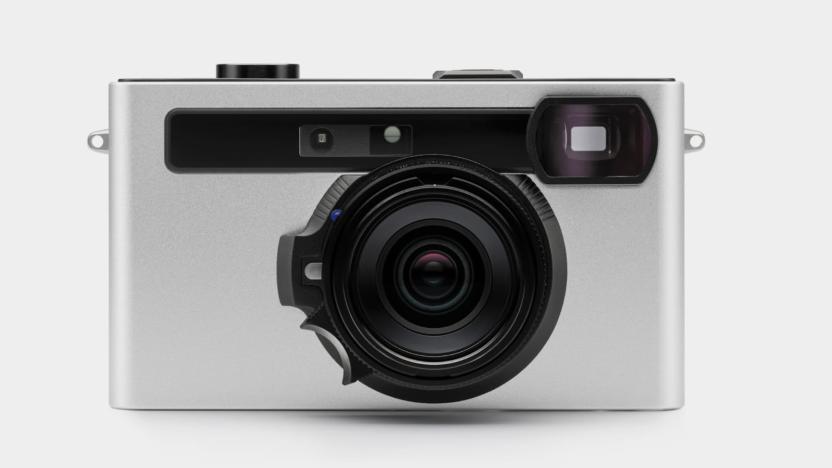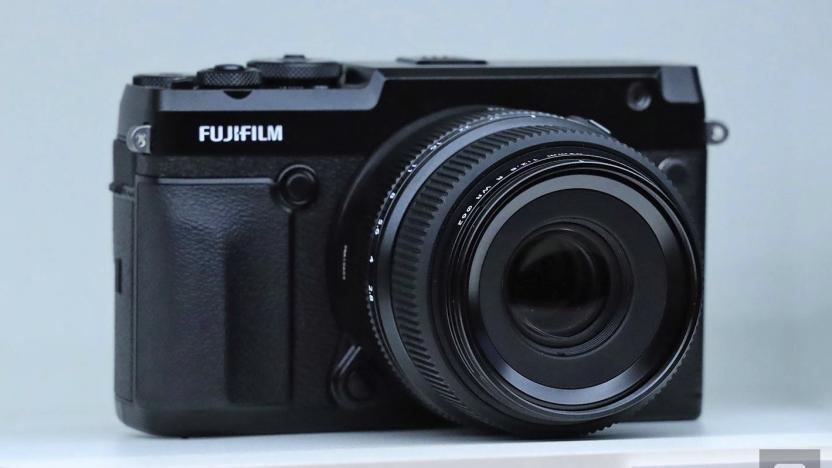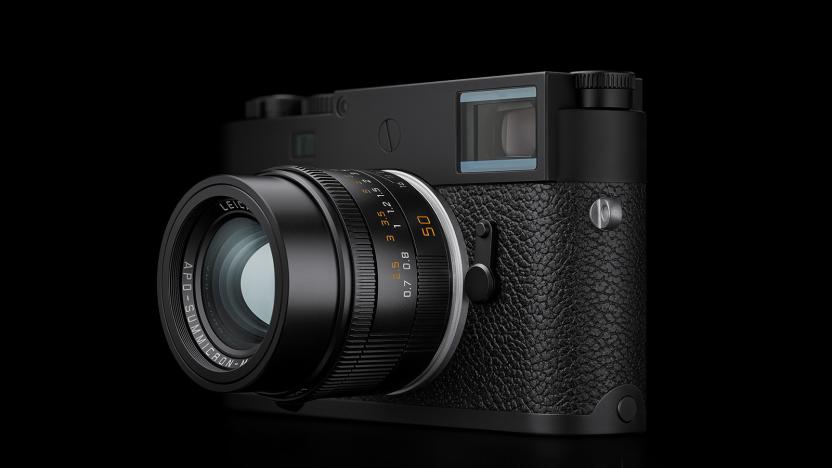rangefinder
Latest

Leica's 41-megapixel M10-R rangefinder is made for landscape photography
Now the German manufacturer has released its highest-resolution model yet, the $8,295 full-frame, 40.9-megapixel M10-R. Unlike past models, it has more potential for landscape or city photography requiring maximum detail. For one, it now makes a good landscape or portrait camera. Both have 3-inch TFT rear displays, 100-50,000 ISO ranges, Maestro II image processors and Leica’s split-screen manual focus system.
Steve Dent07.16.2020
Leica's M10 Monochrom is devoted to black-and-white photography
Leica is giving its Monochrom cameras a much-needed upgrade, and it's good news if you're a big fan of black-and-white photography... provided you're willing to pay the price. The company has introduced an M10 Monochrom that's superficially based on the M10-P rangefinder, but switches to a new 40-megapixel sensor that, thanks in part to the absence of a color filter, produces a more "analog" black-and-white picture than applying a software effect to a regular image. To call the sensor an upgrade would be an understatement. In addition to a big jump in resolution over its 24MP predecessor, the M10 Monochrom has a considerably wider ISO 160 to ISO 100,000 range that should help capture moody night scenes.
Jon Fingas01.19.2020
Fujifilm's X-Pro3 can focus in almost complete darkness
Fujifilm has officially unveiled the X-Pro3, the latest in its esoteric X-Pro lineup aimed at street photographers and photojournalists. Teased last month, it has a number of eccentric features, including a 3.5-inch, 1.65-million dot rear display that you can't even see without flipping down. Otherwise, it only shows the shutter speed, aperture and other basic information, or the film simulation if you're using one. The idea is to free the photographer from distractions and help them "stay in the moment," as Fujifilm puts it. "With your mind and your eye always on the scene in front of you rather than the scene you've just shot, you can find a connection not just with your subject, but also with your art," the company wrote in a press release.
Steve Dent10.23.2019
Leica's new 'entry' M rangefinder camera costs $3,995
Good news: Leica just made its M-series cameras more accessible... relatively speaking. The company has introduced an M-E (Typ 240) model that preserves the compact rangefinder design and a 24-megapixel full-frame CMOS sensor, but at a slightly easier to swallow $3,995 price. It's not what we'd call a budget camera, but it beats spending thousands of dollars more. You will have to live with some limitations, though.
Jon Fingas06.24.2019
Pixii is a smartphone-centric rangefinder camera with a Leica mount
If you were thinking "I really want a rangefinder camera with a Leica M mount and no rear display or memory card," then a new French startup called Pixii has read your mind. It unveiled a digital rangefinder, also called Pixii, that it calls "a radical take on what a modern camera should be." Instead of packing a display on the back, all photos are meant to be viewed on your smartphone. And to compose the photo, there's an old-school optical rangefinder rather than an electronic viewfinder.
Steve Dent10.22.2018
Fujifilm's GFX-50R is a smaller 'budget' medium format camera
Two years ago, Fujifilm made a fateful decision to skip over full-frame mirrorless cameras and go bigger with the medium-format GFX-50S. Now, it's doubling down on that with the 51.4-megapixel GFX-50R, a smaller and cheaper version of the original. As the rumor mill had suggested, it looks a lot like its compact X-E3 mirrorless camera, but don't be thinking you'll slide this into your pocket. It's still a 775 gram camera (without a lens) that outweighs Sony's A7R III and at $4,500, costs a lot more, too.
Steve Dent09.25.2018
Leica's M10-P rangefinder has an ultra-quiet mechanical shutter
Leica has unveiled the M10-P rangefinder, an update to last year's M10 with a couple of changes that makes it even more discreet and technically proficient. The biggest change is a new mechanical shutter that's Leica's quietest ever, even more so than its old film cameras that were famous for their silent operation. It's not completely noise-free like, say, Sony's A7 III in silent mode, but unless you're right next to your subject, they likely won't hear a thing.
Steve Dent08.21.2018
Leica's M10 rangefinder gives you full mechanical control
Unless you're really fond of its lens system, Leica's M-series range-finders have always been a tough sell -- models like the M8 and M9 have limited features, and they cost a fortune. Leica has just launched the M10, though, and is trying to give you a bit more (and less) for your money. The mirrorless model is now as small as classic film cameras like the M7 and weighs about the same. It's also got a new ISO-adjustment mechanical dial so that you don't have to dip into the menus, which again makes for a more Leica-like experience.
Steve Dent01.19.2017
Leica's M-D is a digital camera for manual purists
You may be able to live without WiFi on your camera, but would you be willing to ditch JPEG capture, autofocus and any kind of electronic screen? Oh, and pay $6,000 for the privilege, plus thousands more for a lens? If not, you don't fit into Leica's target market for its latest model, the 24-megapixel M-D. The company calls it a "purely functional" camera that's "radically reduced to the most important parameters required for photography -- shutter speed, aperture, distance and ISO sensitivity."
Steve Dent05.02.2016
Hands-on with Leica's super-rare $19,400 M Edition 60
As of this writing, 15,000 Euro is the equivalent of $19,400 -- a very reasonable exchange rate indeed, and a fair price to pay for a mid-range car or a year of college. Only a select few can justify handing over that sum for a digital camera, however, regardless of the exclusivity that comes in tow. Leica's counting on at least a few die-hard fans to fork over the cash, though, for the M Edition 60, a very special model created to celebrate the M system's 60th anniversary. Only 600 have been made, and each is numbered between 001 and 600. Most peculiar is what this camera doesn't include -- a display, menu system, electronic viewfinder or any indicators at all, besides a tiny red light that flashes when the SD card is in use.
Zach Honig09.16.2014
Leica's latest rangefinder camera is both speedier and stealthier
Digital rangefinder cameras may look like retro fashion items, but they're genuinely handy for pros -- they're good for moments when you need quality without carrying a big, conspicuous DSLR. To that end, Leica has just launched the M-P, a new addition to the M series that's more about serious work than style. You're still getting a 24-megapixel full-frame sensor in a relatively small body, but the buffer memory has doubled to a hefty 2GB; the camera should almost always keep up with your rapid-fire photography. There's also a new selection lever that shows you framing for common focal lengths in the viewfinder, and an anti-reflective coating on the scratch-resistant sapphire LCD will help you review your snaps in bright sunlight.
Jon Fingas08.22.2014
Leica M-E is a $5,450 M9 with new color scheme, minor feature exclusions (hands-on video)
Don't have the $6,500 to spare to pick up a Leica M9? You might consider the freshly announced M-E, which carries a similar feature set and a slightly more palatable $5,450 price tag. The camera includes the same 18-megapixel sensor as the M9, but drops relatively minor features like a built-in USB port (you'll need to pop out your SD card to download pics). It's nearly identical to the pricier model, with a low-res (230k-dot) 2.5-inch LCD and an ISO range of 160-2500. Unlike the "new M," announced alongside the M-E, the latter model does not offer live-view functionality, so you'll only be using the LCD to make settings adjustments and for reviewing images, anyway. Shot framing will be handled with the 0.68x viewfinder, positioned at the top left of the camera. Aesthetically, you might find the M-E to be a bit more pleasing, with a muted gray/black color scheme -- we found it to be quite nice during out hands-on at Photokina. The camera itself looks like an M9 with a hint of Michael Graves-esque simplicity -- there's a silver shutter speed dial up top, with soft numbering and positions that range from bulb to 1/4000 second. There's also a matching power toggle/shutter release, along with the standard suite of playback and ISO controls on the rear. As we mentioned, the 2.5-inch display offers a bit lower resolution than what we'd like to see, making it less than ideal for verifying image sharpness, for example, so if the LCD marks high on your list of priorities, you'll probably do best to wait for the "new M" (M10) to hit early next year. Otherwise, the M-E appears to be a capable camera, but M9 owners should hang tight -- there's not much to see here. The M-E is available for purchase now, for about $5,450 (or €4,800 in Europe), and you can sneak a peek in our gallery below, and the hands-on video after the break.%Gallery-165706%
Zach Honig09.18.2012
New Leica M camera has live-view and 1080p video capture, we go hands-on (video)
Yesterday, Canon stole the show, but today's darling of Photokina appears to be the just-announced Leica M camera. Show attendees flocked to the "new M" demo counter this morning, nudging through the crowd for a chance to check out Leica's first live-view equipped M. This new feature is powered by a new 24-megapixel CMOS sensor, and also enables 1080p video capture at 24 and 25 frames-per-second -- another first for Leica. Live-view and HD video shooting may not seem like banner features for a €6,200 (about $8,100) camera, but considering they've never been offered before, these additions seem to be highlights for hopeful M10 owners. The camera itself is quite beastly, in typical M fashion, and appears to have just as much heft as the M9. There's a new Gorilla Glass-equipped 3-inch, 920k-dot display, that's plenty sharp and quite responsive in live-view mode. Adjacent to the display, you'll find a new LV button, which, as you may have guessed, launches the new realtime display mode. There's also a playback button, along with direct access to ISO, image deletion and menu settings. Up top, there's the Leica trademark shutter speed dial (aperture control is on the lens), letting you select from bulb all the way through 1/4000 second. There's a full-size hot shoe up top with an accessory connector for the EVF 2 attachment, and a second proprietary connector on the bottom to interface with the accessory grip, which adds USB connectivity and built-in GPS. We can't comment on image quality just yet, but there's no question that the "new M" marks Leica's commitment to finally bring otherwise commonplace features to its popular (and pricey) rangefinder line. Look for this latest model to hit stores in early 2013, but you can take a closer look today in our hands-on gallery below and video demo after the break. Update: This post originally stated that the new Leica M had yet to be named, however the company has confirmed that the new camera will simply be named, "The Leica M," without numbers. "The Leica M also marks the beginning of a new era in the Leica product naming policy. In [the] future, Leica M and S model names will omit the number suffix to emphasize the enduring and long-term significance of the respective systems."
Zach Honig09.18.2012
Leica Monochrom test turns up the ISO, doesn't bring the noise
In the case of "why would you pay $8k for a black and white camera," exhibit 'A' would surely be the lack of a color filter array corrupting the image. Without one, the Leica Monochrom -- with a similar CCD to its M9 stablemate -- should have less noise. Tests comparing the two cameras on Red Dot Forum confirm it, with the Monochrom cleaner in glorious black & white at all ISO's up to the M9's maximum of 2500. Past that, a touch of NR gave the Monochrom a pleasing film-grain look to our eyes at ISO 5000, but at ISO 10,000 images started to sparkle and approach the "barely usable" range. Still, combined with the increased sharpness and resolution, very well-heeled purists might be tempted.
Steve Dent05.30.2012
Laser-toting MAV can find its way in tight spaces, might eventually hunt you down (video)
A perpetual weakness of MAVs (micro air vehicles) is their frequent need for hand-holding in anything other than a wide-open or very controlled space. If they're not using GPS or motion sensors to find their locations, they can't turn on a dime the way a human pilot would. Adam Bry, Abraham Bachrash and Nicholas Roy from MIT's CSAIL group haven't overcome every problem just yet, but they may have taken combat drones and other pilotless aircraft a big step forward by giving them the tools needed to fly quickly when positioning isn't an option. Uniting a laser rangefinder with an existing 3D map of the environment -- still 'cheating,' but less dependent -- lets the prototype flyer find the distance to nearby obstacles and steer clear even at speeds that would scare any mere mortal MAV. Ideally, future designs that can create their own maps will be completely independent of humans, making us think that MIT's references to "aggressive" autonomous flight are really cues to start hiding under the bed.
Jon Fingas05.17.2012
HD video possible in upcoming Leica compact, bon vivants check trust funds
Full-frame HD video in a brand new compact body, with Leica lenses? It could happen, but if you have to ask why exorbitant Leicas don't already do video then you probably can't afford it. While still calling the feature "theoretical", Leica's chairman Dr. Andreas Kaufmann intimated that the company had solved issues with data rate, battery life and heat for a possible M9 replacement. He also said that HD would be shown soon on "existing and new models", and Leica would stick with Truesense imaging, the former Kodak shop which supplies the M9 CCD, to make the new full-frame sensor. Whether that means video could also be retrofitted to existing M-series rangefinders remains to be seen, but more will be revealed on September 18th. Until then, if you need to make an extravagant splurge, the Hermes M9-P, perhaps?
Steve Dent05.14.2012
Leica teases our wallets with $50,000 Edition Hermès M9-P, $1,000 scarf sold separately
If you've ever wondered if designer names alone can send a product's price tag through the roof, this should suffice as confirmation. Hermès, the Parisian fashion giant best known for its prohibitively expensive wearable accessories, has teamed up with Leica for some creative marketing. Two special M9-P editions will be available -- a total of 300 Edition Hermès digital rangefinders will ship beginning in June for $25,000, while 100 "very special" (even more exclusive) Edition Hermès - Série Limitée Jean-Louis Dumas models will be available in July for, ahem, $50,000 (that's fifty thousand, in case you assumed it was a typo). Likely realizing that it would be insanely absurd to unload the M9-P for either price without lenses included, Leica has opted to offer both as complete kits. The less expensive version uses some fancy calfskin leather with a silver chrome finish, and ships with a Leica Summilux-M 50 mm f/1.4 ASPH. optic. The "very special" version, on the other hand, includes a Leica Summicron-M 28 mm f/2 ASPH., a Leica Noctilux-M 50 mm f/0.95 ASPH. and a Leica APO-Summicron-M 90 mm f/2 ASPH -- all finished in anodized silver. It also comes with a bag and a book. Due to the incredibly limited production run, you'll probably want to pitch a tent (or have your assistant park their assistant's Maybach) outside the Washington DC Leica Store, beginning sometime later this month. Update: Need little more convincing about the craftsmanship? There are making-of and unboxing videos embedded after the break.
Zach Honig05.10.2012
Leica M Monochrom captures exclusively in black and white, costs far more than your color-abled shooter
Wildly colorful photos got you down? There's an 18-megapixel full-frame sensor for that. The Leica M Monochom may seem an unlikely proposition, with its monochrome-only sensor and $8,000 price tag (not to mention the added financial burden that comes along with investing in a Leica M-mount), but the camera offers some unique benefits that, for some, may justify the cost. Because the sensor is capable of outputting one pixel of data for each pixel captured -- there's no hint of color mucking about -- the resulting images are incredibly sharp. There are low-light benefits as well, with the Monochrom offering a top ISO setting of 10,000, compared to 2500 with the aging M9. Other features include a 2.5-inch 230k-dot color LCD, a rangefinder-type optical viewfinder and a 14-bit uncompressed RAW mode that yields 36MB DNGs. The camera itself offers an appearance consistent with other Leica snappers, and includes a magnesium alloy construction with hints of brass and chrome. Naturally, there's no video features to speak of, so no 1080p black-and-white shoots for you. We do have pricing and availability, however, though we don't exactly have the funds to match. The body-only M Monochrom is expected to retail for $7,970 when it hits stores (beginning with Leica's Washington DC showroom) in July. A new Leica APO-Summicron-M 50 mm f/2 ASPH prime lens will be available around the same time, for the modest sum of $7,195. There's a full PR just past the break. Update: DPReview has posted a gallery of sample images. Don't be so quick to dismiss this camera -- plenty of deep-pocketed photographers have likely been waiting for something just like it. Hit up the source link after the break for the shots.
Zach Honig05.10.2012
Leica's M9-P to be offered in unicorn-guise, $31,770 and Japan-only
Currently drowning in more cash than sense? Do you also call the land of the rising sun home? Excellent, as we've found the perfect camera just for you: the elusive white variant of Leica's M9-P. Restricted to only 50 units, the unicorn shooter will go on sale come June for a cool 2,620,000 yen (or around $31,770) -- a hefty premium over the regular (read: black and chrome) permutations which cost $7,995. Granted those pedestrian versions don't come wielding an insane f/0.95 50mm lens out of the box. And if this ridiculous combo is priced out of your league, you could always go after its cheaper, yet also delectable white predecessor -- although we'll hazard you're going to need more than just luck finding it.
Dante Cesa03.22.2012
FujiFilm's $1,700 X100 Black Edition now shipping, limited to 10K units worldwide
We somehow missed this retro-styled gem at back at CES, but no matter -- Fujifilm's X100 Black Premium Edition is now shipping and available for purchase. This is exactly the same 12.3-megapixel camera that's been pleasing photographers for nearly a year, albeit in a darker, single-tone finish that's limited to a run of 10,000 units worldwide. Priced at $1,700, the black X100 is 500 more bones than the standard-issue variant and features the same 23mm fixed lens, but it comes with a lens hood, leather case, clear lens filter and an adapter ring; all of which are all painted to match. We'd say this blacked-out shooter gives the NEX-7 a run for its money in the dapper looks department, but you can decide for yourself at the source link below. Full press release past the break.
Joe Pollicino03.09.2012